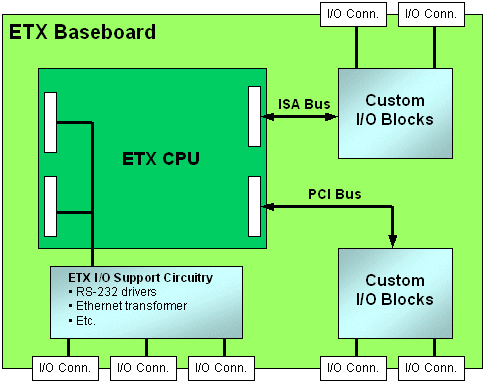|
The I/O portion of a COM baseboard is divided into the following two categories.
 |
Standard System I/O |
Standard system I/O is driven from the COM CPU module itself and can include:
| RS-232/422/485 serial ports |
| 10/100 & Gigabit Ethernet |
| USB 2.0 & USB 3.0 |
| VGA CRT, LVDS, HDMI, Display Port |
| Keyboard & mouse |
| ISA, PCI or PCIe expansion buses |
 |
I/O Added to the Baseboard |
Any I/O can be added to the baseboard. This can include your own design, third party circuits, or I/O technology from Diamond's extensive library of power and I/O circuits. Diamond's library includes:
| Analog input with 12-bit or 16-bit resolution, up to 250KHz |
| Analog output with 12-bit or 16-bit resolution, up to 100KHz |
| Digital I/O with programmable direction & interrupt on change of state |
| Relays & opto-isolated digital I/O |
| Counters & timers |
| Full protocol serial ports |
| USB 2.0 & USB 3.0 |
| 10/100 & Gigabit Ethernet |
| IEEE1394 Firewire |
| CANbus 2.0 with opto-isolation |
| GPS location tracking |
| GSM/GPRS and CDMA wireless communications |
| DC/DC power supply with wide input range |
| Battery backup & charger circuitry |
| PCIe, PCI & ISA bridges |
| PCIe MiniCard & FeaturePak sockets |
Diamond Systems' application engineers work with you to bring the COM I/O you need out to connectors of your choice on the baseboard. Next we help you select from our extensive selection of proven I/O circuitry, including analog I/O, digital I/O, communications and networking to provide the specific additional functionality needed for your application.
|
 |
Downloads |
 |
|
|
 |
COM Standard I/O Options |
 |
|
 |
2 Serial ports (TTL signaling) |
 |
SATA interfaces for hard disk, solid-state flashdisk, or CompactFlash devices |
 |
Floppy / parallel port interface (shared pins) |
 |
10/100Mbps & Gigabit Ethernet |
 |
Keyboard & mouse |
 |
4 USB ports |
 |
VGA CRT interface |
 |
LVDS or TTL flat panel interface |
 |
PCIe and PCI expansion buses for slot boards, PC/104-Plus boards, or PCIe MiniCards |
|
 |
Diamond's Baseboard I/O Options |
 |
|
|
Data Acquisition
|
 |
Analog Input, 12-bit or 16-bit resolution, up to 250KHz |
 |
Analog Output, 12-bit or 16-bit resolution, up to 100KHz |
 |
Digital I/O, programmable direction and interrupt on change of state |
 |
Relays |
 |
Optoisolated digital I/O |
 |
Counter / Timers
|
|
Communications / Networking
|
 |
Serial ports with RS-232, RS-422, and RS-485 interfaces |
 |
USB 2.0 & 3.0 ports |
 |
10/100Mbps & Gigabit Ethernet |
 |
IEEE1394 Firewire |
 |
CAN 2.0 with opto-isolation |
 |
GPS location tracking |
 |
GSM/GPRS and CDMA wireless communications
|
|
Other Baseboard Circuitry
|
 |
DC/DC power supply with wide input range |
 |
Battery backup / charger circuitry |
 |
PCIe to PCI and PCI to ISA bridges |
|
|
|

We can include your own custom application circuitry, or, if necessary, create new logic blocks to meet your needs. Because many of Diamond Systems’ I/O logic blocks are based on reprogrammable FPGA technology, we can also provide existing FPGA code to implement many I/O functions or create new FPGA code to implement application-specific I/O requirements. As your needs change, new designs can be downloaded to the FPGA to upgrade your board without incurring engineering redesign expenses.
|